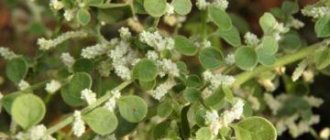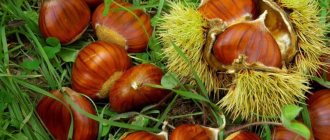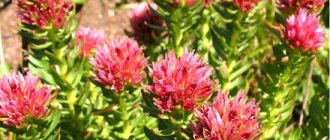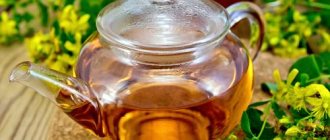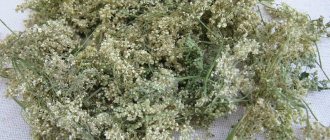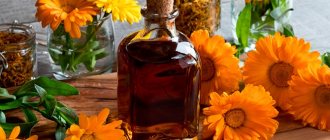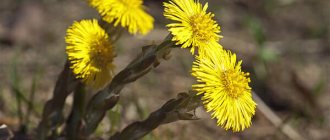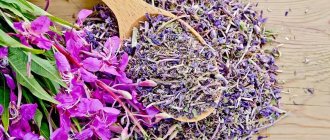Aspen: chemical composition
In different parts of the plant, the concentration of active components differs slightly, but the chemical composition is the same.
It is the presence of valuable chemicals that determines the medicinal properties of the plant. Therefore, it is important to know exactly what substances nature has combined in this plant in order to use them correctly. Aspen contains the following components: essential oils; tannins; polysaccharides; carotenoids; flavonoids; antioxidants; glycosides; organic acids; coumarins; vitamins (A, C, group B, E, K, PP); mineral compounds and salts. Thanks to its rich composition, the plant has a beneficial effect on the nervous and cardiovascular systems. Aspen bark and leaves are used to treat diseases of internal organs, indigestion, and disorders of the liver and kidneys.
This plant is a famous herbal remedy for fighting intestinal parasites. It can even be used to treat children and animals, as it does not have the same side effects as antihelminthic pharmaceutical drugs.
Description of the plant
The height of a mature tree can reach 30 m, width - 50-100 cm. Life expectancy - up to 150 years. The root system is well developed and deep, which makes the tree stable in strong winds. The bark of a young tree is olive-colored, smooth, while that of an adult tree is dark gray, with small cracks.
The leaves are round in shape with jagged edges, attached with thin petioles. Long and laterally compressed petioles lead to constant vibration of the leaves. That is why the impression of continuous trembling of the crown is created.
Aspen is a dioecious plant. The catkins of the male tree are reddish in color, about 15 cm long, while the female ones are narrower and shorter, greenish in color. The flowering time of the plant is April-May, after 35 days the seeds ripen. The tree reproduces by both seeds and root suckers.
, tree bark is most often used to prepare decoctions and infusions . The beneficial properties of aspen bark are due to the fact that it contains:
- tannins, which have an anti-inflammatory effect on the gastric mucosa, remove heavy metals;
- glycosides with diuretic, laxative, sedative, expectorant and disinfectant effects;
- pectin and lignan - means for lowering cholesterol levels, normalizing metabolism and hormonal levels;
- a sterol that strengthens the human cardiac system;
- a whole range of trace elements, including iron, zinc, copper, nickel and molybdenum.
The leaves contain no less useful components:
- a large group of carbohydrates that provide the body with energy, normalize metabolic processes, and sugar content;
- vitamins, including ascorbic acid, necessary to enhance immunity and improve capillary permeability;
- anthocyanins, which will reduce the fragility of capillaries and blood vessels, relieve inflammation and strengthen the heart muscles.
Aspen buds , the medicinal properties of which are undeniable, are included in a variety of herbal preparations. A tincture made from them will help get rid of many ailments. Aspen buds contain:
- resinous substances that have a bactericidal, wound-healing effect;
- essential oils to improve the functioning of the central nervous system and enhance the secretion of glands.
- wax, which has a bactericidal effect, is used to treat non-healing wounds and skin diseases.
Aspen juice contains almost all of the listed beneficial components, but in lower concentration.
The healing properties of aspen
Aspen is used not only in alternative medicine. Quite often it is also used in general complex treatment regimens, as an auxiliary, restorative and supportive agent.
The tree is so popular for one simple reason - it has numerous medicinal properties. A list of the therapeutic benefits of aspen bark, leaves and catkins is below.
- The collection eliminates inflammation, both when used externally and internally.
- Thanks to the content of antioxidants, vitamins and flavonoids, the plant strengthens the immune system and helps to quickly cope with bacterial and viral infections.
- Aspen has a pronounced diuretic effect, and due to the content of organic acids it helps with urolithiasis. Together with the antibacterial and anti-inflammatory effect, this property is used in the treatment of diseases of the urinary system.
- Aspen bark has a beneficial effect on the gallbladder and liver, stimulates cell restoration, and helps more actively process toxins and fats. Indicated for use in cases of congestion, cholecystitis, cholelithiasis, and hepatitis.
- The plant strengthens the heart, helps quickly cleanse blood vessels of cholesterol, tones their walls and increases elasticity.
- The plant has a mild laxative effect, restores microflora and intestinal motility.
- Aspen helps cope with a lingering cough. It eliminates its causes - inflammation in the respiratory tract and infections.
- Aspen is a popular anthelmintic that copes with various types of parasites without harm to health.
- The bark of the plant helps reduce sugar levels and regulate metabolic processes in diabetes mellitus.
- Using herbal medicine can reduce high blood pressure and normalize well-being in case of hypertension.
Thanks to the use of aspen-based products, you can generally improve your health, increase your resistance, and improve your well-being. Tea based on plant raw materials replenishes the deficiency of minerals, vitamins and antioxidants, adds vigor and strength.
Use in cosmetology
Aspen is known to be used not only for medical purposes. In cosmetology, such preparations are used as lotions, compresses, and creams. Aspen bark extract is a nourishing agent that also softens the skin, activates the production of collagen and elastin and improves the color and condition of the skin and mucous membranes.
Adding a decoction or extract of this product to baths or using them in a sauna helps increase elasticity and even out the color of the skin of the body. Such procedures nourish the skin, give it a velvety and fresh appearance, and also protect the mucous membranes from pathogenic microflora.
Aspen collection and preparation
For busy people who do not have time to collect and prepare medicinal raw materials, there are ready-made preparations that can be bought at a pharmacy or any store that sells organic products. But you can also prepare the required amount of raw materials yourself. The following parts of the plant are used for medicinal purposes: bark; earrings; twigs; leaves.
All this can be effectively used for preparing decoctions, infusions, ointments, and balms.
But you need to know the basic rules for procuring raw materials, which will help you get the most useful harvest.
- You need to choose an area where all plants are not exposed to toxic substances. Ecologically safe regions are located far from industrial facilities, plants, factories, wastewater treatment plants and highways. It is also important to have a normal background radiation in the area where the raw materials will be collected.
- The best time to collect bark is early spring, when the process of sap movement has just begun. During this period it contains the maximum amount of active substances.
- The bark must be cut carefully, in small strips. Vertical. You cannot make circular cuts. In order not to damage the tree during the period of sap flow, it is better to cut the bark from the branches, and not from the main trunk.
- Leaves can be collected throughout the season, except for the flowering period. It is also undesirable to collect immediately before the beginning of leaf fall. It's better to do this in the middle of summer.
- Leaves should only be dried on cloth or paper; do not use a dryer or oven.
- The twigs need to be collected in the spring - from April to the end of May. They need to be carefully cut and dried in the oven at 40 degrees.
To prevent the harvested raw materials from spoiling, you need to seal it tightly. For such purposes, it is convenient to use glass jars with plastic lids. Sometimes raw materials are stored in boxes and fabric bags. But this method has a disadvantage - the raw materials can become damp or absorb foreign odors. In such situations it will become unusable.
Diabetes treatment
The beneficial properties of aspen bark have been used in the fight against diabetes, due to the presence of substances in plant materials that serve as a natural substitute for insulin. Diabetics are recommended to drink a decoction from the bark of this tree along with professional medications. It is especially effective in the early stages of the disease. As a rule, such a course is designed for 2 months of regular use. If necessary, re-treatment is carried out no earlier than 3 weeks after the end of the course.
Aspen traditional medicine recipes
Alternative medicine contains dozens of aspen-based recipes, and all of them can be useful in practice if used correctly. But it is not always necessary to know all the several dozen options for preparing medicinal products. Sometimes just basic, classic recipes are enough.
Infusion
The simplest remedy to prepare is an infusion. It can be created from leaves and buds. It is better to boil the bark and branches, but in some cases they can also be infused. To create an infusion, you need to use a clean enamel pan with a lid, a thermos, or even a thick ceramic cup that reliably retains heat. Here are the recipe options:
- 30 grams of earrings per 600 ml of water, pour and keep in a thermos for 4 hours;
- 20 grams of leaves and 500 ml of water, keep covered for 2 hours;
- Take 20 g of leaves and catkins, pour boiling water to the top in a liter jar, keep covered for 3 hours.
Drink an infusion of 50-100 ml for colds, acute respiratory infections, gout, diabetes and urinary tract infections. This medicinal composition can also be used externally to treat skin affected by fungus or allergic rash.
Decoction
A decoction can be prepared from catkins or bark; it is better not to use the leaves for such purposes, because they lose some of their active components during the cooking process. You can prepare the decoction according to the following recipes:
- 50 grams of bark to 1.2 water - simmer in a saucepan for 40 minutes so that a third of the liquid evaporates and leave;
- Boil 20 grams of earrings and the same amount of bark in a water bath for 1 hour in a liter of water, leave.
The decoction allows you to extract the full potential of the medicinal raw material, the full concentration of active components. In addition, the decoction can be stored longer; during the boiling process, all pathogenic bacteria are destroyed in it; you can stock up on the finished medicine for 5-6 days and store it in the refrigerator.
Aspen tea
Tea should be brewed immediately before use. The following types of raw materials are used for it: bark; leaves; young branches; catkins and plant buds.
What are the benefits of aspen bark?
Having an anti-inflammatory effect, the bark of this tree is an effective remedy for attacks of dry cough in diseases of the upper respiratory tract and oral cavity. It has proven well in the fight against infectious diseases of the digestive system due to its bactericidal properties.
Important! Aspen remedies should not be taken for illnesses that are accompanied by a wet cough, as they do not relieve phlegm.
Aspen bark successfully eliminates pain and reduces inflammation in muscles and joints. It enhances the ability of tissues to regenerate, as a result of which wound healing accelerates and the overall resistance of the body to the harmful effects of the environment increases.
Preparations containing aspen raw materials effectively deal with helminths, especially opisthorchids - worms from the class of flukes that enter the human body when eating infected river fish fillets.
In addition, thanks to beneficial antioxidants and essential oils, aspen bark has a tonic effect on the human body, eliminates appetite problems and strengthens the immune system.
For men
Aspen bark has significant benefits for the male body. It has a positive effect on the production of male sex hormones and improves blood circulation in the pelvic organs. As a result, potency increases and sexual desire increases.
The healing properties of aspen bark often help with some oncologies and in the case of harmful disorders of the genitourinary system, in particular with prostate adenoma.
For women
Aspen bark products are also useful for women. They are used during painful menstruation to reduce cramps. Aspen is also used for weight loss as a dietary supplement to food. Since the bark of this plant improves metabolism and helps eliminate harmful toxins and excess fluid, it successfully helps fight unwanted pounds.
Recommended reading: Benefits of boiled beets for the body
For children
Aspen formulations can also be taken by children. The beneficial substances of the plant safely affect the growing child’s body, helping to speed up metabolism and improve appetite. They are also effective for diathesis, enuresis and various intestinal infections. However, decoctions and infusions from aspen bark should be given only with the permission of the pediatrician and if children do not have allergic reactions to this plant material.
Methods of using aspen
There are many folk recipes for all occasions. For each individual diagnosis, the methods of using aspen in folk medicine differ. Below are the most common treatment regimens for each disease.
Diabetes
To restore normal well-being in diabetes mellitus and control blood glucose levels, it is necessary to use young aspen branches (fresh or dry), as well as an infusion on the buds. Tea made from the leaves of this tree is also useful. Read more about each treatment method below.
- Tea from the leaves is brewed immediately before use and drunk 2-3 times a day before meals.
- Young branches (20 grams) are used to prepare a decoction - boiled in 700 ml of water for half an hour, and then infused for 2-3 hours. You need to drink 50 ml of the strained mixture before each meal.
- Kidneys (30 grams) are poured into 600 ml of boiling water in a thermos and infused for 5-6 hours. You need to drink the infusion 2 times a day, 100 ml.
For diabetes mellitus, aspen medicines can sharply reduce blood sugar levels, so there is no need to experiment - you should consult your doctor before use.
Gout
Aspen helps with gout for one simple reason - it contains salts and organic acids that restore the natural course of metabolism in the body. The plant forces the body to process excess uric acid and stimulates the kidneys to quickly remove toxic breakdown products. For gout, use the following recipe:
- 40 grams of bark; 800 ml water; boil for 30 minutes.
You need to drink 50 ml of the decoction every 2 hours for 10 days, and then switch to three times a day and continue the course of treatment for a whole month. Gout requires long-term treatment. Along with the decoction, you need to adjust your diet so that the body can cope better with uric acid, and you should also drink plenty of fluids to flush out all poisons and toxins.
Fungus
Fungal infections of the nails and feet can also be treated with aspen. For nail fungus, use an alcohol tincture made from earrings. You need to pour 1.5 tablespoons of raw material with 100 ml of alcohol and leave for 21 days.
The finished tincture should be instilled under the affected nails, and also used for wiping every day, 2 times - in the morning and in the evening.
If a fungal infection has affected the skin of the feet, it is necessary to use baths based on an infusion of a mixture of leaves and catkins. To prepare the base, use ½ cup of crushed leaves and the same amount of catkins.
You need to pour 2 liters of boiling water over the raw material, wait for the infusion to cool to a comfortable temperature and pour it into a basin. Immerse your feet in the container for 20 minutes, then dry them with a towel and put on clean socks. This procedure must be done every evening for 20 days.
Description of the common aspen tree
Common aspen (or trembling poplar) is a tree with a columnar trunk, the maximum height of which is 35 m, while the diameter of the trunk reaches 1 m. This plant is distinguished by rounded leaves with fairly large teeth along the edge. Read also: Mangosteen: beneficial properties, contraindications, benefits and harm.
Because of the long roots that are flattened in the middle, aspen leaves begin to tremble even with a slight blow of wind. Aspen (like other types of poplars) is a dioecious tree, as a result of which entire sections of tree stands can consist of male or female individuals.
Thus, male flowers have pink or red earrings, while female flowers have green earrings. This is a fairly fast-growing breed, which grows up to 20 m in 40 years.
However, aspen is not durable, and often lives about 90 years (rarely the age of aspen is 130 - 150 years). There are different types of aspen, which differ in the color and structure of the bark, the time of leaf blooming and other characteristics. But in folk medicine it is the common aspen that is used, the properties and application of which will be discussed in detail below.
Hypertension
It is quite possible to get rid of high blood pressure with the help of aspen, because this plant produces the following therapeutic effects:
- eliminates excess cholesterol;
- relaxes the walls of blood vessels;
- normalizes the functioning of the heart and strengthens its muscles.
During attacks, you need to drink an infusion of aspen catkins, prepared according to the classic recipe in a volume of 100 ml. To prevent attacks, it is recommended to periodically undergo a monthly course of treatment 2 times a year - drink an infusion of 50 ml 3 times a day.
Aspen with acute respiratory infections
Aspen helps with flu and colds no worse than antiviral drugs. Tea is used for treatment. It should be drunk 4-6 times a day with honey. You can make tea from twigs, leaves or earrings.
To enhance the effect, it is recommended to wait until the tea has cooled to 60 degrees and add 1 teaspoon of honey to the serving. Aspen has a pronounced antiviral, antibacterial, anti-inflammatory and antipyretic effect.
Using other parts of the tree
A very useful alcohol tincture is made from aspen branches mixed with the bark and leaves of the tree. It is drunk by patients with gastrointestinal problems, people suffering from hemorrhoids and genitourinary ailments. They take the medicine in the form of drops.
Aspen root often becomes the basis of healing ointments. It is ground into powder and mixed with vegetable oil (1:4). Used for gout, rheumatism, arthritis - rub the drug into painful places.
At the same time, aspen juice helps get rid of warts, eliminating other skin diseases. To prepare it, take a log and heat it over a fire or in an oven. It is the heat that causes the tree to release foaming sap. It must be applied to the affected areas of the skin three times a day.
Aspen for cough
Aspen tree helps to cope with severe dry cough due to pneumonia, flu and bronchitis. But it is also effective for prolonged chronic cough with an abundance of sputum.
Plant materials are used to prepare infusions, which must be consumed warm. You can also use the powder obtained from aspen catkins to make cough syrups and lozenges. Syrup recipe:
- boil 3 tablespoons of earrings in 150 ml of water;
- strain;
- add 3 tablespoons of sugar and the juice of half a lemon to the resulting broth;
- boil for 5-7 minutes.
The syrup can be used 3-4 times a day, 1 teaspoon for 4-5 days. You can simply steam aspen catkins with boiling water and drink 50 ml of liquid 4-5 times a day.
Arthritis and rheumatism
Aspen has the ability to relieve joint pain and bring relief from exacerbation of rheumatism and arthritis. In order to use the plant in the treatment of such diseases, you need to prepare a vodka tincture and ointment.
- For vodka tincture you need to take 30 grams of dry buds and the same amount of dry tree bark. The raw materials must be kept for 2 weeks in 500 ml of vodka, strained and used for daily compresses every evening.
- The ointment can be prepared on the buds or on the bark - collect, dry, boil 3 tablespoons of bark or buds in 300 g of fat, strain and pour into a clean jar.
Aspen ointment can cause a warming effect. It can be applied after an evening half-hour compress with vodka. Before using these products, be sure to make sure there is no allergic reaction.
Prostatitis
Aspen bark is one of the most popular types of plant materials used in the treatment of prostatitis. A decoction or infusion is prepared from it. Or alcohol tincture for oral administration. When using products based on aspen bark, the following therapeutic effects are observed:
- elimination of inflammation;
- normalization of urination;
- reducing the severity of pain;
- restoration of reproductive function.
Aspen contains plant compounds that can restore organs and tissues of the genitourinary system in men. But it is important to monitor the results during treatment in order to adjust the course in time.
Healing potions
The medicine can often be found in the following forms:
- Tincture of aspen bark. Its use is possible for cystitis, gastritis, hemorrhoids, dysentery. The infusion is prepared simply - in a ratio of 1:10, that is, for one part of the medicinal raw material, take 10 parts of alcohol (40%). The liquid is infused for four days, after which it is filtered. Drink one teaspoon of the infusion three times a day.
- Decoction. To make it, they take the buds, bark and leaves of the tree. Drink for arthritis, gout, inflammatory processes of the bladder. The decoction is useful for pregnant women to drink during the rehabilitation period after major operations. Together with the tincture, it is also taken as an antipyretic.
- Extract. Can be purchased at a pharmacy. It has many beneficial properties: normalizes sleep, improves immunity, treats anemia, strengthens the nervous system. Helps in the treatment of cancer. Take the medicine three times a day, 10-20 drops.
Aspen contraindications
Aspen bark is contraindicated for use in case of hypersensitivity. If there is intolerance, external and internal use should be discontinued, because such treatment will not bring any benefit. It is also prohibited to use aspen bark for the following diseases and conditions:
- chronic constipation;
- children under 12 years of age;
- pregnancy;
- breast-feeding;
- renal failure;
- individual intolerance.
In other situations, aspen can be used without negative consequences. This plant is so effective in treating diseases that in the old days people attributed magical powers to it and endowed it with some supernatural qualities.
If you dose correctly and do not overuse herbal raw materials, you can quickly and effectively cope with various diseases and conditions.
Good luck and health to everyone!
Useful properties of aspen bark
The health benefits of aspen bark are not limited to its antipyretic effect. In addition, tree bark has a number of other beneficial properties and is used as a remedy:
- diaphoretic;
- antibacterial;
- anti-inflammatory;
- choleretic;
- pain reliever;
- anthelmintic;
- against cough
And although in traditional pharmacology aspen bark serves only as a biological additive, the benefits of this substance are highly valued in folk medicine.
https://vsem-privet.ru/osina-polza-i-vred-recepty-protivopokazaniya/
Series of messages “Kidneys and urinary tract”:
Part 1 - Cleansing the genitourinary system Part 2 - Decoctions for cleansing the kidneys ... Part 36 - The best herb for removing kidney stones Part 37 - Treatment of the kidneys with folk remedies Part 38 - Aspen - medicinal properties, benefits and harms , folk recipes for use Part 39 - Kidney cleansing with folk remedies Part 40 - 7 natural drinks that will help cleanse the kidneys at home ... Part 45 - 5 herbs for kidney diseases Part 46 - Onion peels for 100 diseases Part 47 - Goldenrod (golden rod) – treatment of kidneys, prostatitis, cholecystitis, etc.
Series of messages “3-I-O”:
Part 1 - How to speed up your metabolism? Part 2 - Means of detoxifying the body... Part 11 - How to get rid of nail fungus Part 12 - Burdock: for kidney stones, diabetes, gout and rheumatism Part 13 - Aspen - medicinal properties, benefits and harms, folk recipes for use Part 14 - Onion peel , medicinal properties and contraindications
Series of messages “Prostatitis”:
Part 1 - Chronic prostatitis and prostatic hypertrophy Part 2 - Doctor Evdokimenko: How to cure cystitis in 1 day - without pills and antibiotics ... Part 10 - Burdock: for kidney stones, diabetes, gout and rheumatism Part 11 — GARLIC HONEY AND VINEGAR — increases immunity, treats insomnia, asthenia, hypertension Part 12 — Aspen — medicinal properties, benefits and harms, folk recipes for use Part 13 — Recipe for the prostate gland and the treatment of prostatitis Part 14 — Herbal tea as an assistant in the fight with prostatitis... Part 16 - Onion peel, medicinal properties and contraindications Part 17 - Milk thistle: beneficial properties and contraindications. Recipes Part 18 - Goldenrod (golden rod) - treatment of kidneys, prostatitis, cholecystitis, etc.
Series of messages “Medicine.
plant Forest_3": Part 1 - DANDELIONS Part 2 - Nettle: benefits, applications, contraindications ... Part 22 - Burdock: for kidney stones, diabetes, gout and rheumatism Part 23 - Pine cones for the treatment and prevention of strokes Part 24 - Aspen - medicinal properties, benefits and harms, folk recipes for use Part 25 - Juniper: properties and contraindications, its use Part 26 - Wormwood (chernobyl) - medicinal properties and contraindications ... Part 34 - Lupine: medicinal properties Part 35 - Mullein: medicinal properties and contraindications Part 36 - Milk thistle: beneficial properties and contraindications. Recipes
Series of messages “Cold_2”:
Part 1 - Ginger wrapped in cloth removes mucus from the lungs in 1 night! Here's what to do Part 2 - Thyme (thyme) - benefits and harms... Part 4 - For colds - cheap remedies tested in the USSR Part 5 - GARLIC HONEY AND VINEGAR - increases immunity, treats insomnia, asthenia, hypertension Part 6 - Aspen - medicinal properties, benefits and harms, folk recipes for use Part 7 - Use of laundry soap for health and beauty Part 8 - Beetroot: benefits and harm to the health of the body ... Part 10 - Meadow chin - medicinal properties and contraindications Part 11 - Onion peels for 100 diseases Part 12 - Pine for colds, atherosclerosis, neuroses and for rejuvenation
Benefit
The bark is one of the most useful parts of the aspen tree. Its healing properties are invaluable. Due to the presence of a large amount of carbohydrates and tannins, it is actively used as a natural antimicrobial agent. As for the core, it often becomes the main component of healing ointments, since its anti-inflammatory properties have long been known to science. Such drugs are often recommended to patients for the treatment of ulcers, wounds, and burns.
Fox and kidney are effective cough remedies. Herbal medicines made on their basis dilute mucus and remove it from the bronchi. In addition, aspen buds are used to prepare propolis. It is widely used to treat a large number of ailments. It is also invaluable in cosmetology due to its rejuvenating, soothing and moisturizing effect.
Possible harm
The medicinal properties of aspen can do more harm than good if you take drugs based on it orally in the presence of the following factors:
- disturbance of intestinal motility, expressed in frequent constipation;
- diseases of the digestive system;
- pathologies of the bladder and kidneys;
- dysbacteriosis
- pregnancy and breastfeeding;
- tendency to allergic manifestations;
- increased susceptibility to constituent components.
You should definitely consult a doctor about the possibility of using aspen for people suffering from prolonged cough and endocrine disorders of carbohydrate metabolism.
Getting rid of parasites
Aspen bark has proven itself well as a medicine against worms. Tannins, tannins present in the plant, destroy the bodies of helminths and remove them from the body without harm to humans. Alcohol tinctures are most successful against parasites. They are often taken for opisthorchiasis and giardiasis.
However, the medicinal properties of aspen bark tincture will not bring benefit to people with cirrhosis of the liver, since alcohol can cause harm in this disease. In this case, it is best to cleanse the body of worms using a decoction.
